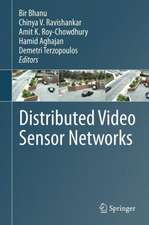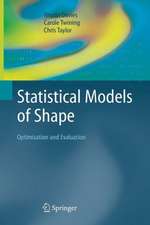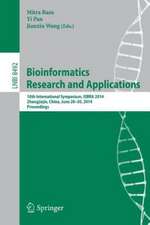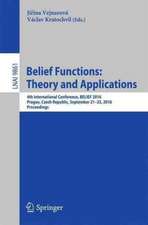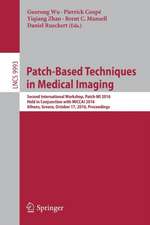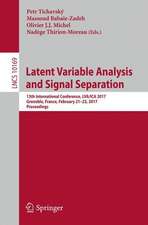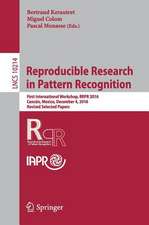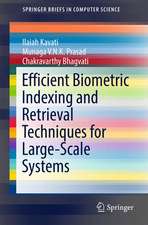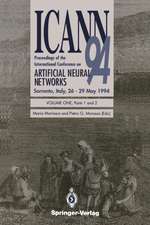Data Complexity in Pattern Recognition: Advanced Information and Knowledge Processing
Editat de Mitra Basu, Tin Kam Hoen Limba Engleză Paperback – 22 oct 2010
This book takes a close view of data complexity & its role in shaping the theories & techniques in different disciplines & asks:
- What is missing from current classification techniques?
- When the automatic classifiers are not perfect, is it a deficiency of the algorithms by design, or is it a difficulty intrinsic to the classification task?
- How do we know whether we have exploited to the fullest extent the knowledge embedded in the training data?
| Toate formatele și edițiile | Preț | Express |
|---|---|---|
| Paperback (1) | 988.00 lei 6-8 săpt. | |
| SPRINGER LONDON – 22 oct 2010 | 988.00 lei 6-8 săpt. | |
| Hardback (1) | 993.09 lei 6-8 săpt. | |
| SPRINGER LONDON – 17 oct 2006 | 993.09 lei 6-8 săpt. |
Din seria Advanced Information and Knowledge Processing
- 20%
 Preț: 330.44 lei
Preț: 330.44 lei - 20%
 Preț: 53.43 lei
Preț: 53.43 lei - 20%
 Preț: 1042.28 lei
Preț: 1042.28 lei - 18%
 Preț: 726.85 lei
Preț: 726.85 lei - 20%
 Preț: 646.30 lei
Preț: 646.30 lei - 20%
 Preț: 990.80 lei
Preț: 990.80 lei - 20%
 Preț: 647.61 lei
Preț: 647.61 lei - 20%
 Preț: 996.56 lei
Preț: 996.56 lei - 20%
 Preț: 994.40 lei
Preț: 994.40 lei - 20%
 Preț: 985.03 lei
Preț: 985.03 lei - 20%
 Preț: 654.37 lei
Preț: 654.37 lei - 20%
 Preț: 989.79 lei
Preț: 989.79 lei - 20%
 Preț: 991.27 lei
Preț: 991.27 lei - 15%
 Preț: 645.79 lei
Preț: 645.79 lei - 20%
 Preț: 817.55 lei
Preț: 817.55 lei - 20%
 Preț: 991.46 lei
Preț: 991.46 lei - 18%
 Preț: 1114.83 lei
Preț: 1114.83 lei - 20%
 Preț: 589.93 lei
Preț: 589.93 lei - 20%
 Preț: 995.75 lei
Preț: 995.75 lei -
 Preț: 454.92 lei
Preț: 454.92 lei - 20%
 Preț: 992.62 lei
Preț: 992.62 lei - 20%
 Preț: 645.14 lei
Preț: 645.14 lei - 20%
 Preț: 647.61 lei
Preț: 647.61 lei - 20%
 Preț: 638.69 lei
Preț: 638.69 lei - 18%
 Preț: 955.08 lei
Preț: 955.08 lei - 20%
 Preț: 643.97 lei
Preț: 643.97 lei - 20%
 Preț: 983.02 lei
Preț: 983.02 lei - 20%
 Preț: 645.31 lei
Preț: 645.31 lei - 18%
 Preț: 950.96 lei
Preț: 950.96 lei - 20%
 Preț: 921.17 lei
Preț: 921.17 lei - 20%
 Preț: 653.71 lei
Preț: 653.71 lei - 20%
 Preț: 988.00 lei
Preț: 988.00 lei - 18%
 Preț: 947.67 lei
Preț: 947.67 lei - 20%
 Preț: 1004.99 lei
Preț: 1004.99 lei - 20%
 Preț: 650.92 lei
Preț: 650.92 lei - 20%
 Preț: 998.21 lei
Preț: 998.21 lei - 20%
 Preț: 642.65 lei
Preț: 642.65 lei - 20%
 Preț: 997.38 lei
Preț: 997.38 lei - 20%
 Preț: 650.59 lei
Preț: 650.59 lei - 20%
 Preț: 647.61 lei
Preț: 647.61 lei
Preț: 988.00 lei
Preț vechi: 1235.00 lei
-20% Nou
Puncte Express: 1482
Preț estimativ în valută:
189.06€ • 202.16$ • 157.63£
189.06€ • 202.16$ • 157.63£
Carte tipărită la comandă
Livrare economică 18 aprilie-02 mai
Preluare comenzi: 021 569.72.76
Specificații
ISBN-13: 9781849965576
ISBN-10: 1849965579
Pagini: 316
Ilustrații: XVI, 300 p.
Dimensiuni: 155 x 235 x 17 mm
Greutate: 0.45 kg
Ediția:Softcover reprint of hardcover 1st ed. 2006
Editura: SPRINGER LONDON
Colecția Springer
Seria Advanced Information and Knowledge Processing
Locul publicării:London, United Kingdom
ISBN-10: 1849965579
Pagini: 316
Ilustrații: XVI, 300 p.
Dimensiuni: 155 x 235 x 17 mm
Greutate: 0.45 kg
Ediția:Softcover reprint of hardcover 1st ed. 2006
Editura: SPRINGER LONDON
Colecția Springer
Seria Advanced Information and Knowledge Processing
Locul publicării:London, United Kingdom
Public țintă
ResearchCuprins
Theory and Methodology.- Measures of Geometrical Complexity in Classification Problems.- Object Representation, Sample Size, and Data Set Complexity.- Measures of Data and Classifier Complexity and the Training Sample Size.- Linear Separability in Descent Procedures for Linear Classifiers.- Data Complexity, Margin-Based Learning, and Popper’s Philosophy of Inductive Learning.- Data Complexity and Evolutionary Learning.- Classifier Domains of Competence in Data Complexity Space.- Data Complexity Issues in Grammatical Inference.- Applications.- Simple Statistics for Complex Feature Spaces.- Polynomial Time Complexity Graph Distance Computation for Web Content Mining.- Data Complexity in Clustering Analysis of Gene Microarray Expression Profiles.- Complexity of Magnetic Resonance Spectrum Classification.- Data Complexity in Tropical Cyclone Positioning and Classification.- Human-Computer Interaction for Complex Pattern Recognition Problems.- Complex Image Recognition and Web Security.
Textul de pe ultima copertă
Machines capable of automatic pattern recognition have many fascinating uses in science and engineering as well as in our daily lives. Algorithms for supervised classification, where one infers a decision boundary from a set of training examples, are at the core of this capability. Tremendous progress has been made in refining such algorithms; yet, automatic learning in many simple tasks in daily life still appears to be far from reach.
This book takes a close view of data complexity and its role in shaping the theories and techniques in different disciplines and asks:
• What is missing from current classification techniques?
• When the automatic classifiers are not perfect, is it a deficiency of the algorithms by design, or is it a difficulty intrinsic to the classification task?
• How do we know whether we have exploited to the fullest extent the knowledge embedded in the training data?
Data Complexity in Pattern Recognition is unique in its comprehensive coverage and multidisciplinary approach from various methodological and practical perspectives. Researchers and practitioners alike will find this book an insightful reference to learn about the current status of available techniques as well as application areas.
This book takes a close view of data complexity and its role in shaping the theories and techniques in different disciplines and asks:
• What is missing from current classification techniques?
• When the automatic classifiers are not perfect, is it a deficiency of the algorithms by design, or is it a difficulty intrinsic to the classification task?
• How do we know whether we have exploited to the fullest extent the knowledge embedded in the training data?
Data Complexity in Pattern Recognition is unique in its comprehensive coverage and multidisciplinary approach from various methodological and practical perspectives. Researchers and practitioners alike will find this book an insightful reference to learn about the current status of available techniques as well as application areas.
Caracteristici
Shows how to appreciate the presence and nature of patterns in specific problems Helps the reader set proper expectations for classification performance Offers guidance on choosing the best pattern recognition classification techniques Interdisciplinary coverage helps the reader absorb and apply useful developments in diverse fields: Engineering, Computer Science, Social Sciences and Finance



